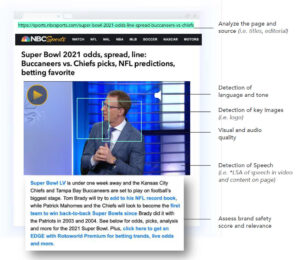With Google and other search engines phasing out third-party cookie data, brand marketers will finally have to acknowledge the value and impact of this tool, a pillar of online marketing.
Privacy is a societal concern that either by regulation or consumer demand will make targeting consumers more challenging. What will replace what the privacy movement has suppressed, and what can we do to obtain/leverage first-party data? A lot, actually. The way we see it, the market has already responded by turning this challenge into a bigger opportunity.
 Context is King
Context is King
It will be more important than ever to leverage other sources of third-party data, as well as alternative tools, such as contextual targeting techniques with lifestyle-relevant messaging and reaching consumers in appropriate media environment. To put this simply, contextual targeting displays ads based on the content a user is looking at instead of their overall behavior profile.
For our client Winning Streak Sports, the leaders in premium licensed, sports team décor, we targeted the fans of Chiefs and Buccaneers football teams and drove viewers to Winning Streak’s Super Bowl collection eCommerce page.
We were able to place our message in the thick of Super Bowl news, social and search story lines—where consumers were engaged, viewership of our message heightened, and click through was greatest. We did this by focusing on thousands of contextually appropriate media environments with the right sports and lifestyle news, and we used third-party data targeting to reach Bucs and Chiefs fans (as well as leveraging key works like Tom Brady!),
The Solutions that Know the Shopper Best Win!
The process of pushing contextual marketing and shopping tools deepened our understanding, and we learned how to identify and target relevant audiences. The market is evolving quickly, and we continue to discover new software and solutions that help our clients make the transition and get closer to their shopper.
While established players are busy re-tooling and upping their game, new entities are getting in on the action, working to develop “people-based targeting,” with methodologies and various products and services to reach and track consumers in the digital space. In general, people-based marketing uses data a marketer has collected (first-party brand data) to identify exact customers and their behaviors. This approach is even more targeted than cookie-based campaigns because it uses data to form an online identity, whereas cookies are limited to devices.
Consider The Trade Desk, the leading, independent, cloud-based, demand-side platform (DSP), which is used to buy digital ad inventory. The Trade Desk’s programmatic platform leverages artificial intelligence and big data to automate the purchase and targeting of digital ads, meaning ad buyers can spend their budget more efficiently. The Trade Desk (and other DSPs) not only enable the buying of ads, they also provide the ability to target audiences, set bid parameters, collect and analyze data, and optimize campaign performance.
Marketers can now use analytics to connect to the right consumers (who shop the right stores), and this will take cross-device ROI measurement to a whole new level. We’re excited about the innovation we are seeing now, and great things are coming soon, including an accelerated shift to connected TV. But one thing is for sure, the opportunity continues to grow, with or without cookies.
Retail Media Networks—A Game Changer?
Retailer-specific marketing campaigns have always been highly effective, but with the emergence of data-driven digital analysis and targeting, it’s retailer-specific on steroids. Retailers own first-party data, so they own the consumer relationship, thus they are in the best position to understand and impact the path to purchase. Retailers are building out their own media networks by partnering with, hiring, and acquiring vast digital data expertise, so they can dive deep and surface the most meaningful intelligence about a consumer’s purchasing behavior—and deploy their media tools effectively. It’s a nifty, closed-loop system—fueled by facts. (Plus, they can sell the data to generate incremental revenue. Amazon has been a great teacher.)
Big players, like Walmart, Target, Kroger, and Walgreen’s have already established their own retailer-connected media properties and vehicles. But other retailers are gearing up to join the fight, including smaller chains and independents. Consider Wakefern, the largest retailer-owned cooperative in the United States, comprising 50 member companies who independently own and operate 344 retail supermarkets in the northeast. They have a VP of Brand Strategy, a VP and Director of Digital Strategy, and a Director of Digital Commerce, plus they have partnered with a digital placement/media firm, and have named a digital marketing agency of record. We haven’t seen this kind of sophisticated approach before. With the blurred lines between marketing, media and trade spending, brands need to get out of their marketing and sales silos to work with multiple chains or be selective to assemble a national plan.
Building on the Numbers
With unprecedented access to all this data, it’s tempting to think that everything is knowable, and that all the answers are in the numbers. But numbers provide an incomplete picture (they can tell us who, what, where, and when but not the all-important why.) The consumer is a multi-dimensional being and we often recommend a multi-faceted, fully integrated marketing approach (informed by primary and secondary research, trend analyses, social listening, etc.) to break through the clutter and compel the consumer to seek out and purchase the brand (in whatever retail channel or medium they prefer).
And for those with immediate needs, or who simply need to improve velocity, we focus on promotional tactics that fill a contextual role in people’s lives and compel the consumer to act immediately, whether they pull a product off the shelf, or click to basket.
Will we miss the supplement brand that follows us like a puppy everywhere we go online? It clearly worked but at what cost to consumer privacy concerns? There is good news now and on the horizon: We can keep consumers’ privacy top of mind and still find a better way to take data and other tools to the next level and drive shopper insights.
With new solutions at our disposal, and an analytical, intuitive, creative, and strategic mindset, we can find a better way to reach shoppers, engage more deeply and learn something new in the process. Cookies may crumble, but the slice of the shopper marketing and media pie is still getting bigger and more exciting every day! Connect with us to strengthen your digital strategy.

